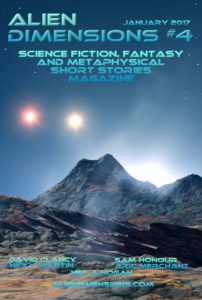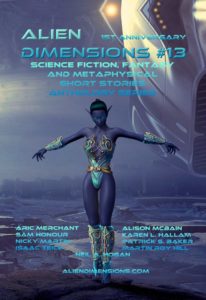English and Sanskrit (Hindi) in Alien Dimensions Issue 11
Alien Languages
One of the things that fascinated me as a child was the idea of a truly alien language. We have ancient human languages, mathematical languages, programming languages and even deliberately created languages like Indonesian, not to mention TV languages like Gallifreyan and Klingon, that seem fairly alien. But we have never found a truly alien language. Even crop circle messages seem to be created with higher maths in mind and easily decipherable.
The movie ‘Arrival’ had me over the moon at the idea of a circular alien language that was not time dependent. It was fascinating and probably closer to what a real alien language would be like.
While we can’t yet receive television signals of alien characters and their lives (if they even know what storytelling means) we can still encounter languages that are alien to us in the world around us. Dolphins, whales and other animals speak their own language which are just now being deciphered. When we crack all the dolphin dialects, we’ll have taken the next step towards being able to understand a truly alien language.
In the meantime, though, I thoroughly recommend anything that may have you encountering another language. So, when Shashi submitted his work ‘Prospector of the Silica Seas’ I was entranced by the inclusion of transliterated Ancient Sanskrit. However, I had no idea he actually had a version with the actual words in Mangal font. As soon as I found this out, after issue 11 was published, I immediately requested he send me the original version, with the idea that I would reedit the edited version in issue 11 and put the Sanskrit words in where they belong. He kindly obliged and I set to work on Tuesday night.
Trials and Tribulations
OMG! I had no idea trying to put more than one language into an ebook would be such a drama!
If you ever want to publish something that contains more than one language, and get it to work on multiple systems, a myriad of conversion programs and eventually on Kindle, please read this. It is not for the faint of heart.
Firstly, Microsoft Word wouldn’t show the Sanskrit words in his file. They remained blank in Word for Windows 2013 64 bit. The system said I had Mangal font and the document required it but it just wasn’t displaying. Converting to Adobe pdf also didn’t show the font – just a blank space.
I downloaded several Hindi font packs including Mangal and installed them – that didn’t work.
I changed the proofing language in Word to get it to edit the font. Nup
I highlighted the Sanskrit word area and went through hundreds of the fonts. Only one showed boxes. The rest were blank.
What?
What in the Word?
Shashi kindly sent me a pdf with the Sanskrit words embedded. I was able to read that in Adobe, but opening it in Word meant the font was still blank. And converting a docx to a doc meant the blank spaces completely disappeared!
At least I now knew it was a Word problem.
I then read through a number of forums. Many who had upgraded from Windows 7 to Windows 10 had had the same problem as me. Fonts that were on the system and installed, just weren’t connecting to the programs.
I then found Windows 10 had separate font packs that operated in a different way to the fonts within Microsoft Office. So, I spent an hour downloading a few I needed.
I then restarted, tested, restarted again, and was finally able to see the Sanskrit fonts in Shashi’s file in Word!
Yay!
It’s editing time
After editing and creating a glossary for the story, I then spent some time replacing the transliterated words with the original Sanskrit words, and testing that it saved correctly. Different fonts and languages meant the book design reset, so that had to be corrected.
Of course, converting to pdf X-1a format for printing via Createspace meant that Adobe replaced the original Word font with its own Mangal version. Still, it looked okay. I have submitted it to Createspace and am awaiting their approval for the update.
But, then it was time to create the Kindle version.
Kindle requires web page unfiltered html format. Guess what happens when I choose that?! The Sanskrit font disappears!
So, another search online and I found that, for Hindi fonts, KDP requests a doc or docx file to be able to retain the language.
Recreating Issue 11 for the 11th time, (images move with every format change) I was able to reedit and get the fonts working in KDP Amazon.
Great!
But…
As I had had to use a unicode notepad to store the Sanskrit words, and copy from there, even though I was careful to not copy any spaces, the words still created a ‘Hindi space’ letter in the text. After another hour of recopying and pasting and uploading and testing, I’ve had to give up. I was able to remove a few of the Hindi space letters but not all of them. I feel that changing the font size of the overall story to make it look more consistent, added the spaces, and I can’t really go back without starting again. I decided to leave it there. Kindle’s preview program shows that at least the Glossary of Sanskrit words is correct.
At the end of it all, to add an extra language besides English to the publication, it has taken an extra 10 hours of time and hair tearing, and I’m not entirely happy with the result in the ebook version. I’m hoping the printed version will work out better.
You might be thinking, why bother?
I do casual work as a private conversation and pronunciation tutor for English. I’ve always had an interest in different languages, and am a beginner in German, Japanese, Indonesian, Mandarin and Korean. Seeing some writer-created words in a text, whether they are from a known language, researched or made up, adds an additional element of alienness to the work. If I could make it easy to not only read other language words in submissions writers send me, but then be able to print in all languages, it would open up Alien Dimensions to even more interesting stories. I’m very excited by this idea.
So, if you’re thinking about creating your own series with multiple languages, I hope this post has been helpful to you.
And, if you are thinking of submitting to Alien Dimensions, but have included a few non-English words in your text and aren’t sure whether it will be looked at, never fear. I’d be happy to read a story about aliens in multiple languages.
Even though KDP Amazon can’t yet accept more than 40 different languages (Chinese, Korean and Thai aren’t available yet, for example) the worst case scenario is, if your story is chosen for publication, I can always convert the language text to an image. Having said that, Amazon is constantly working to include more languages in the service, and they added Hindi in December 2016.
Find out more about writing for Alien Dimensions here:




